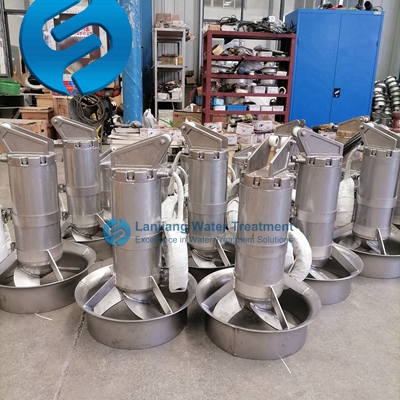The commissioning of the sewage mixer after installation is a key step, which ensures the normal operation and efficient work of the mixer. Here is a detailed debugging procedure for your reference:

First, preparation before commissioning
Check the oil filling:
Fill the oil according to the requirements of the reducer manual, if the manual has indicated that no refueling is required, there is no need to do this step.
Insulation testing:
Test the insulation degree of the drive motor to ensure that the insulation resistance to the ground is not less than 5MΩ to ensure the safe use of the motor.
Electrical connection:
Connect the motor to the control system correctly according to the requirements of the motor connection method. Wiring should refer to the electric control schematic and instructions to ensure the accuracy and safety of the wiring.
Second, no-load test run
Rotation direction check:
After the mixer is installed, the first point adjustment is made to check whether the rotation direction of the mixer is correct. For a vertical hydrofoil mixer, the blade pushes down the flow in the correct direction of rotation.
Idle check:
Start the mixer under no-load condition and observe whether it runs smoothly and whether there is abnormal vibration or noise. The idling time should be long enough to fully check the operating status of the mixer.
Third, load test run
Frequency converter start:
When water enters the pool, it is necessary to use the inverter to start the mixer at a low speed during formal operation. Then the speed is gradually increased several times, and there should be a period of time between each increase in order to observe the adaptation of the mixer.
Current detection:
During the debugging operation, the current of the mixer is detected at any time to ensure that it runs within the rated current of the motor. If the current is found to be abnormally high, stop the machine immediately to check the cause.
Fourth, parameter adjustment and optimization
Stirring parameter setting:
According to the actual need to set the mixer mixing time, mixing speed and other parameters. The setting of these parameters should be based on the nature of the sewage, the amount of treatment and the performance of the mixer.
Effect check:
In the debugging process, pay attention to observe whether the mixing effect of the mixer meets the requirements. If necessary, the mixing parameters can be fine-tuned to achieve the best results.
Fifth, daily maintenance and inspection
Regular inspection:
Check and maintain the key parts of the mixer regularly, such as bearings, gears, seals, etc. Check for wear and replace or repair damaged parts in time.
Recording and analysis:
In the process of debugging and operation, the operation parameters and state of the mixer should be recorded in detail. Discover potential problems through data analysis and take appropriate measures to deal with them.
6. Safety precautions
Power off operation:
Before performing any maintenance or adjustment work, be sure to turn off the power to the mixer and confirm that it is completely out of operation.
Personal Protection:
Operators should wear personal protective equipment, such as safety helmets, protective glasses, gloves, etc., to ensure personal safety.
Through the commissioning and daily maintenance of the above steps, it can ensure the normal operation and efficient work of the sewage mixer, and provide a strong guarantee for the stable operation of the sewage treatment process.
Nanjing LanJiang Water Treatment Equipment Co.,Ltd manufactures equipment for wastewater treatment. We were established in 2001. Since then, we designed and produced submersible mixers, top entry mixers, aerators and other wastewater treatment equipment.
Post time:2024-08-07